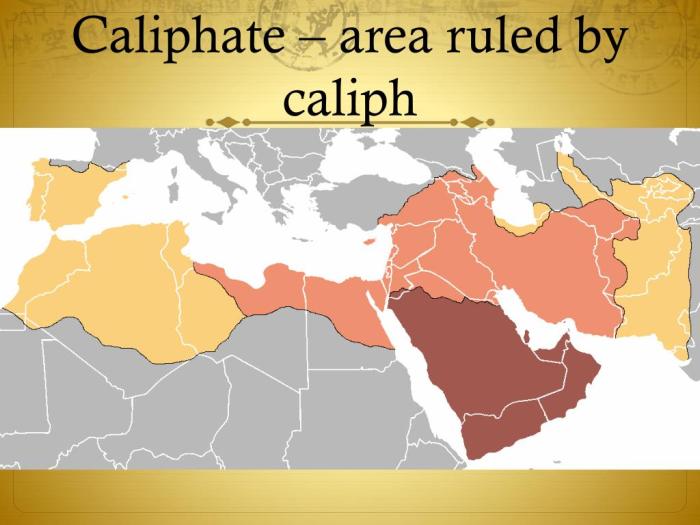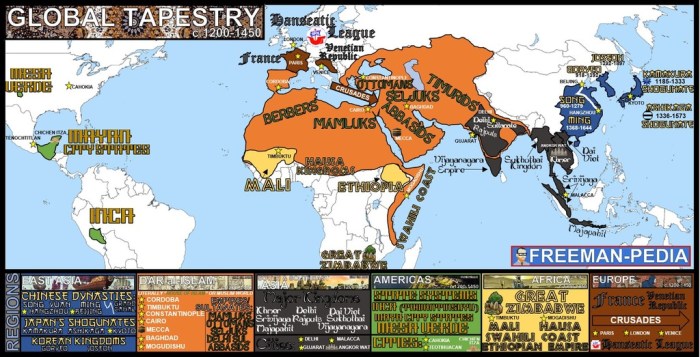The concept of the caliphate, a central pillar in Islamic history, has been subject to various interpretations and transformations throughout time. This exploration of caliphate definition ap world history delves into its origins, evolution, and impact, providing a comprehensive understanding of this pivotal institution.
Emerging from the ashes of the Prophet Muhammad’s passing, the caliphate emerged as a political and spiritual entity, embodying the unity of the Muslim world under a single leader known as the caliph. The role of the caliph, his authority, and the succession process are integral to comprehending the caliphate’s historical trajectory.
Definition of Caliphate: Caliphate Definition Ap World History

A caliphate is a political-religious state led by a caliph, who is considered a successor to the Islamic prophet Muhammad and the leader of the worldwide Muslim community.
The term “caliphate” is derived from the Arabic word “khalifa,” meaning “successor” or “representative.” The first caliph was Abu Bakr, who was elected by the Muslim community after Muhammad’s death in 632 CE.
Historical Interpretations
The concept of the caliphate has been interpreted differently throughout history. Some caliphs have claimed to be the sole legitimate rulers of all Muslims, while others have seen themselves as primarily the leaders of their own territories.
The caliphate has also been seen as a religious institution, a political institution, or a combination of both.
Historical Caliphates
There have been several major caliphates in history, including:
- The Rashidun Caliphate (632-661 CE)
- The Umayyad Caliphate (661-750 CE)
- The Abbasid Caliphate (750-1258 CE)
- The Ottoman Caliphate (1517-1924 CE)
Role of the Caliph

The caliph held both political and religious authority, acting as the successor to the Prophet Muhammad and the leader of the Muslim community. The caliph’s primary responsibility was to ensure the unity and well-being of the caliphate, both spiritually and temporally.
Political Authority
- Governed the caliphate, making laws and enforcing them.
- Led the Muslim armies in battle.
- Appointed and dismissed government officials.
- Collected taxes and distributed funds.
- Maintained order and justice within the caliphate.
Religious Authority
- Interpreted Islamic law and doctrine.
- Led prayers and religious ceremonies.
- Promoted the spread of Islam.
- Protected the holy sites of Islam.
Succession and Appointment
The process of succession to the caliphate varied over time. Initially, caliphs were chosen by consensus among the leading members of the Muslim community. Later, hereditary succession became more common, with the caliphate passing from father to son.
Historical Development of Caliphates

The caliphate system emerged as a central institution within the Islamic world, shaping its political, religious, and cultural landscape. Throughout history, several major caliphates rose and fell, each leaving a lasting impact on the development of Islamic civilization.
Timeline of Major Caliphates
The following timeline provides an overview of some of the most significant caliphates in history:
- Rashidun Caliphate (632-661):The first caliphate, established after the death of the Prophet Muhammad, and led by his close companions.
- Umayyad Caliphate (661-750):Expanded the Islamic empire from Spain to India, establishing Damascus as its capital.
- Abbasid Caliphate (750-1258):Centered in Baghdad, it became a cultural and intellectual hub, witnessing the flourishing of Islamic sciences and arts.
- Fatimid Caliphate (909-1171):Based in Cairo, it ruled over North Africa and parts of the Middle East.
- Ottoman Caliphate (1299-1924):A powerful empire that controlled vast territories in Europe, Asia, and Africa, with its capital in Constantinople.
Factors Contributing to Success and Failure, Caliphate definition ap world history
The success or failure of caliphates was influenced by various factors, including:
- Leadership:Capable and visionary caliphs played a crucial role in maintaining stability and expanding the caliphates.
- Military Strength:Effective armies were essential for conquering new territories and defending against external threats.
- Economic Prosperity:Strong economies provided the resources necessary for infrastructure development, trade, and cultural advancements.
- Internal Stability:Political unity and social cohesion were crucial for maintaining the caliphates’ integrity.
- External Pressures:Invasions, revolts, and geopolitical shifts could challenge the stability and survival of caliphates.
Impact on World History

Caliphates played a pivotal role in shaping the course of world history, leaving an indelible mark on the development of Islam and beyond. Their influence extended far beyond the realm of religion, encompassing cultural, scientific, and political spheres.
Cultural Contributions
- Preservation and Transmission of Knowledge: Caliphates became centers of learning and scholarship, establishing libraries and universities that preserved and disseminated ancient knowledge from various civilizations, including Greek, Persian, and Indian.
- Development of Islamic Arts and Architecture: Caliphates fostered a vibrant artistic culture, characterized by intricate calligraphy, elaborate architecture, and decorative arts. The construction of mosques, palaces, and public works showcased the architectural ingenuity of Islamic builders.
- Spread of Islamic Civilization: Through conquests and trade, caliphates introduced Islamic civilization to vast regions of the world, including North Africa, the Middle East, Central Asia, and parts of Europe. This cultural exchange enriched local traditions and fostered the development of new artistic and intellectual expressions.
Scientific Contributions
- Advancements in Medicine: Islamic physicians made significant contributions to medicine, developing new surgical techniques, discovering the importance of hygiene, and establishing hospitals for the care of the sick.
- Development of Mathematics and Astronomy: Caliphates were centers of mathematical and astronomical research, where scholars made advancements in algebra, trigonometry, and the study of the stars.
- Technological Innovations: Islamic scientists and engineers invented new technologies, such as the astrolabe, the compass, and the printing press, which had a profound impact on navigation, communication, and the dissemination of knowledge.
Political Contributions
- Centralized Governance: Caliphates established centralized governments that brought order and stability to vast territories. They developed administrative systems, legal codes, and taxation policies that ensured the smooth functioning of their empires.
- Expansion of Territory: Through military conquests, caliphates expanded their territories, creating a vast Islamic world that stretched from the Iberian Peninsula to the Indian subcontinent.
- Establishment of Diplomatic Relations: Caliphates established diplomatic relations with other states, fostering trade, cultural exchange, and political alliances.
Legacy of Caliphates
The legacy of caliphates continues to shape the modern world. Their cultural, scientific, and political contributions have had a lasting impact on civilizations across the globe. The architectural wonders of caliphates remain iconic landmarks, while their advancements in medicine, mathematics, and astronomy have laid the foundation for modern science and technology.
Moreover, the concept of the caliphate has remained a source of inspiration and debate within the Muslim world, with some advocating for its revival as a symbol of Islamic unity and others rejecting it as an outdated institution.
Comparison of Caliphates

Caliphates varied significantly in terms of their size, structure, and governance. The Umayyad Caliphate, established in 661 CE, was the largest and most powerful of the early caliphates, stretching from Spain in the west to India in the east. The Abbasid Caliphate, which succeeded the Umayyads in 750 CE, was smaller in size but more centralized in its governance.
The Fatimid Caliphate, founded in 909 CE, was a Shia caliphate based in North Africa that ruled over parts of the Mediterranean Sea and Red Sea regions.
In terms of structure, the Umayyad Caliphate was a highly centralized state with a strong military and administrative apparatus. The Abbasid Caliphate adopted a more decentralized system of government, with greater autonomy granted to provincial governors. The Fatimid Caliphate was a relatively decentralized state with a strong emphasis on trade and commerce.
The reasons for the variations among caliphates are complex and varied. Some of the factors that contributed to these differences include the historical context in which each caliphate was established, the political and economic conditions of the time, and the personalities of the caliphs themselves.
FAQ Insights
What is the primary purpose of a caliphate?
The caliphate serves as a central authority that unifies the Muslim community, providing political and religious leadership.
How was the caliph chosen?
Historically, the succession process varied, but it often involved a combination of election, consultation, and hereditary principles.
What factors contributed to the rise and fall of caliphates?
Internal conflicts, external pressures, economic challenges, and shifts in political alliances played significant roles in the waxing and waning of caliphates.